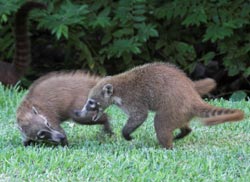Studying the social side of carnivores

The highly social coatimundi, native to Central and South America, has a large frontal cortex -- the part of the brain that regulates social interaction -- compared to other members of the raccoon family.<br>
In studying spotted hyenas, lions and, most recently, the raccoon family, Sharleen Sakai has found a correlation between the size of the animals’ frontal cortex and their social nature.
In her latest study, Sakai examined the digitally recreated brains of three species in the Procyonid family – the raccoon, the coatimundi and the kinkajou – and found the coatimundi had the largest frontal cortex. The frontal cortex is thought to regulate social interaction, and the coatimundi is by far the most social of the three animals, often living in bands of 20 or more.
The study, funded by the National Science Foundation, is published in the research journal Brain, Behavior and Evolution.
“Most neuroscience research that looks at how brains evolve has focused primarily on primates, so nobody really knows what the frontal cortex in a carnivore does,” said Sakai, professor of psychology. “These findings suggest the frontal cortex is processing social information in carnivores perhaps similar to what we’ve seen in monkeys and humans.”
Sakai did the most recent study in her neuroscience lab with Bradley Arsznov, a former MSU doctoral student who’s now an assistant professor of psychology at Minnesota State University. Sakai is one of myriad MSU faculty members who help make the university’s brain research portfolio one of the most diverse in the nation.
Her latest study was based on the findings from 45 adult Procyonid skulls acquired from university museum collections (17 coatimundis, 14 raccoons and 14 kinkajous). The researchers used computed tomography, or CT scans, and sophisticated software to digitally “fill in” the areas where the brains would have been.
When they analyzed into the findings, they discovered the female coatimundi had the largest anterior cerebrum volume consisting mainly of the frontal cortex, which regulates social activity in primates. This makes sense, Sakai said, since the female coatimundi is highly social while the male coatimundi, once grown, typically lives on its own or with another male. Also known as the Brazilian aardvark, the coatimundi – or coati – is native to Central and South America.
Raccoons, the most solitary of the three animals, had the smallest frontal cortex. However, raccoons had the largest posterior cerebrum, which contains the sensory area related to forepaw sensation and dexterity – and the raccoon’s forepaws are extremely dexterous and highly sensitive.
The rainforest-dwelling kinkajou had the largest cerebellum and brain stem, areas that regulate motor coordination. This skill is crucial for animals like the kinkajou that live in trees.
Brain size variations in this small family of carnivores appear to be related to differences in behavior including social interaction, Sakai said.
Media Contact
More Information:
http://www.msu.eduAll latest news from the category: Life Sciences and Chemistry
Articles and reports from the Life Sciences and chemistry area deal with applied and basic research into modern biology, chemistry and human medicine.
Valuable information can be found on a range of life sciences fields including bacteriology, biochemistry, bionics, bioinformatics, biophysics, biotechnology, genetics, geobotany, human biology, marine biology, microbiology, molecular biology, cellular biology, zoology, bioinorganic chemistry, microchemistry and environmental chemistry.
Newest articles

Properties of new materials for microchips
… can now be measured well. Reseachers of Delft University of Technology demonstrated measuring performance properties of ultrathin silicon membranes. Making ever smaller and more powerful chips requires new ultrathin…

Floating solar’s potential
… to support sustainable development by addressing climate, water, and energy goals holistically. A new study published this week in Nature Energy raises the potential for floating solar photovoltaics (FPV)…

Skyrmions move at record speeds
… a step towards the computing of the future. An international research team led by scientists from the CNRS1 has discovered that the magnetic nanobubbles2 known as skyrmions can be…





















